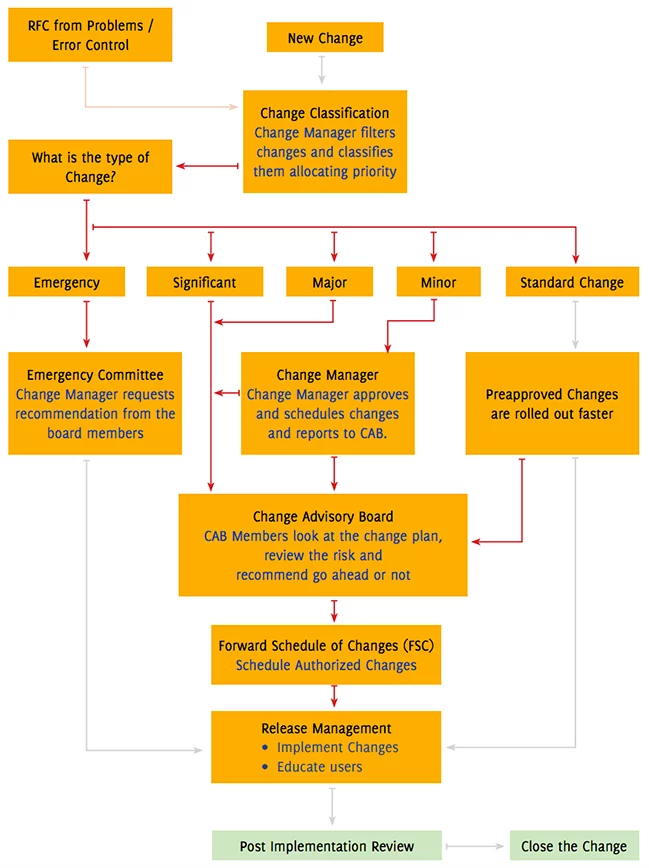
It’s all on you. You’re the key to your organization’s successful change management.
Why? Because you’ve got to design an effective ITIL change management process flow.
“There is no one-size-fits-all approach for [the] change management process. Businesses need to understand their structure, objective, complexity and define change process flows accordingly.” Fresh Service
CEOs need changes to be implemented quickly and successfully. Because it’s critical to their organization remaining relevant and competitive.
The digital revolution is here to stay. And the pace with which you can make systems updates and install new innovative solutions is critical.
ITIL is one framework that can help you to do that.
[lwptoc skipHeadingLevel=”h1,h2,h4,h5,h6″]
What is ITIL change management
ITIL stands for Information Technology Infrastructure Library. It’s a set of IT service management best practices, providing a framework for IT professionals to roll out and prioritize changes efficiently.
IBM played an important role in ITIL’s development and describes it as an “important reference framework for providing a structured approach to IT Service Management.”
Change is a constant for CIOs and IT service managers. At a basic level, systems require updates or become obsolete, so new ones must be installed.
More than that, the demands of a digital-first business world now place an incredibly high burden on change managers to implement innovative tech solutions.
Keep up, or pack up and go home. This is the current landscape.
So it’s vital that IT professionals have access to procedures and best practices to help them execute these changes.
Designing your ITIL change management process flow
Your ITIL change management process flow should follow these eight key stages.
- Creating the request for change (RFC)
- Reviewing the request for change
- Planning the change
- Testing the change
- Creating the change proposal
- Implementing changes
- Reviewing change performance
- Closure
Because there are multiple types of change, there needs to be a step in the process for categorizing and prioritizing RFCs.
The below diagram outlines a basic ITIL change management process flow.
(source: Manage Engine)
Tips for implementing a successful ITIL change management process flow
Your role as a change manager is vital in the organization’s battle to stay competitive. It’s your responsibility to ensure the change management processes you use are relevant and up-to-date.
ITIL is just a framework. It doesn’t guarantee success. It’s what you do with it that counts. So use the following tips to implement an effective ITIL change management process flow.
1. Be strategic
Don’t be content with just “doing” changes. Understand why you’re doing them. What’s the overarching strategy? How does your ITIL change management process flow fit into the bigger picture?
Many organizations choose to integrate ITIL with their own policies and processes. Google, for example, created their own change model.
Consider using an organizational change model, like Prosci’s ADKAR or Kotter’s 8-step process (or your own), alongside ITIL.
2. Communicate
Of course, communication is key.
@BruceHallas – fantastic quote on #communication #infosec pic.twitter.com/9uaGhK8PAB
— Nathan Mielke (@ndmielke) November 16, 2018
Make sure the ITIL change process is communicated clearly to everyone in the IT and/or change team.
It should also be communicated to the rest of the business to promote understanding throughout the organization and avoid unauthorized changes.
3. Equip yourself with tools
Most organizations will need tools to facilitate the ITIL change management process. Tasks like logging RFCs, automating classification, and managing process workflows are a lot easier — and faster — with change management tools.
“Slow and steady might win the race, but if change takes too long, it might be irrelevant.” Jaime Spector, SunView Software
Some change management tools can also provide user adoption, automation, tracking, and reporting help.
4. Engage and share success
People need to know the impact and status of change.
This could be as simple as publishing a calendar of all authorized changes with status updates. So everyone in the business can see what progress looks like.
Or you could conduct team updates with ice-breaker change management exercises, to encourage employees to connect with the process on a more human level.
“Communication – the human connection – is the key to personal and career success.” Paul J. Meyer
5. Test and log everything
Log everything. And test everything. There needs to be a “paper trail” for effective tracking and in case you run into any problems.
Ensure each RFC can be identified by its date and reference number. Then enter as much detail as possible about the change and why it’s needed.
6. Always have a Plan B
Don’t implement any change without a Plan B, or a way to return quickly to a previous stable position.
7. Measure, review, and improve
Change management does not stop at implementation. You must embed evaluation into your ITIL change management process flow so you can refine changes over time.
Gather and review feedback. Measure adoption. How else will you know if the change has been successful?
Some final words of advice
“The rate of change has never been faster than it is today and implementing a quality change management process makes handling constant changeconstant change much more manageable. IT service management company, Cherwell
Make sure you can garner support from the executive suite for change governance so you can get buy-in from staff. This will make your ITIL change management framework easier to implement and follow.
WalkMe Team
WalkMe spearheaded the Digital Adoption Platform (DAP) for associations to use the maximum capacity of their advanced resources. Utilizing man-made consciousness, AI, and context-oriented direction, WalkMe adds a powerful UI layer to raise the computerized proficiency, everything being equal.




